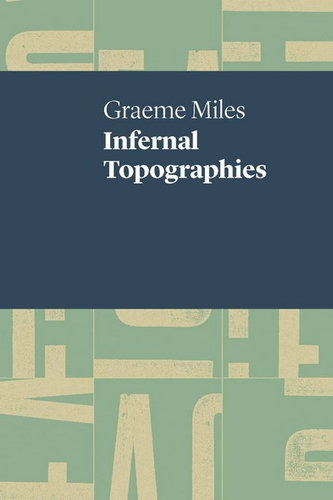 Infernal Topographies by Graeme Miles
Infernal Topographies by Graeme Miles
UWA Publishing, 2020
In Infernal Topographies, Graeme Miles traverses mythology, landscape and notions of selfhood to reveal moments of approachability and tenderness that are rare in Australian poetry. The poems are not so self-referential, nor overtly ambitious. Miles wants to get lost in the musicality of the moment, or the surrender of a second, and so his poems tend to read like reflections on an event that would have otherwise been lost to the everyday eye. Such is the charm of his words. When one reads Infernal Topographies, one reads them not to witness an act of innovation, or sound and image taken to completely new directions, but to meditate on one singular Tasmanian’s relationship to selfhood and tradition.
Let us start with what I consider the strongest poem in the collection, ‘Dunes’. Divided into three shorter poems, ‘Dunes’ peers deep into what appears to be the childhood memories of tan unnamed narrator. The invocation of the poem is a coalescence of memory into landscape.
The dunes perform the same mutations. In sands like these: first swigs of furtive whisky to dull a bit the self-consciousness of adolescent kisses. You could come home with insect bites or love bites vivid on your neck. Always the same smells of coastal scrub: acrid, yet food-like, inhumanly elevating like an incense. Intimate as bodies newly mature.
It’s hard not to imagine the swirling sands while reading these lines: note the wiggling of the sentences caused by the enjambment, the words toppling over themselves. The organisation brings the ups and downs of the dunes into the structure, and yet the language is fundamentally about memory, with ‘love bites vivid on [the] neck’, moments of ‘bodies newly mature.’ What else causes the feeling of being in a sand trap? The chugging of Miles’ language, its perfect combination of mundane household words (‘smells’, ‘food-like’ ‘incense’) with the topographic (‘coastal, acrid, elevating’). The poem imprints the reader in a dust storm by hurling honest lived experiences with no stop for reflection. It acts as an excellent exemplar of how to keep a poem grounded in a specific ecology while writing about events that have nothing to do with that space at all.
The second poem in the suite moves on to being eighteen, the narrator imagining the life he has lived is in fact a dream.
It began with waking, dragging my nauseous body to the thin, buffalo-grass lawn and seeing the remorseless blue sky pulse with the rhythm of blood-vessels behind the eyes.
These lines summon not only the sensations of sight but also the beats of music. Comparing ‘blood-vessels’ to the colours of the sky immediately renders a certain image into the reader’s mind, but then we remember that we are comparing ‘pulse’ with ‘rhythm’, and so we think of the thudding of blood vessels against the arteries, that velocity, that urgency, coupled with the quotidian suburban lawn. The line exists to remind us of the reality behind dreams. Despite the language being lofty, filled with all of the opacity of the ad-hoc clacking of words, Miles seeks to ground us in the corporeal. He is attempting to do justice to not only the surrealism of being inside of a dream, but also the very real parameters of it.
The final poem in the suite brings us to a Tasmanian street – boys partying, getting into fights. One feels fully immersed in the teenage years of suburban and self-destructive Australia. And yet, the ending does not personalise the boys further, nor does it give the reader a chance to delve into their hearts. Instead, Miles takes a cosmic glance upwards.
sky , stars and everything, and all the sharps and flats and in the cool out on the patio the bruises on those mangled boys.
Miles’s poems reflect on vastness and the meaninglessness of individual experience. Sometimes this is done through linking the daily with the divine, the lordly with landscape. Other times, it is through referencing the traditions of Greek mythology and Hinduism. In ‘The Iconoclast’, a discussion takes place between the narrator and a sculptor who has been hired to fix damages done to murtis outside a house.
The sculptor tours us through the damage in the morning, shows us where he’s repaired the impossibly spherical breast of a Lakshmi, one finger from the Ganesh they’ve been doing puja for twice a day for weeks, and the snake-head curled around the neck of an ascetic Shiva outside our door.
The language is simple yet descriptive. The pared-back words give the narrative a sense of reportage. The point of the poem is not to beautify words, but to render a scene, and engross the reader in it. The resulting poetic effect comes, then, not from the language but from the gravitas of the story itself. At the end, the sculptor says, ‘I don’t worry about punishing him, the god will punish him’, implying that those who do bad to others will inevitably receive their comeuppance. And yet, the poem ends not by turning a circle to the conceit, but by sacking the premise entirely:
And after four months he’s gone, this bearded American, taking the stolen pieces like a bag of teeth and charms.
The rhyme between ‘gone’ and ‘charms’ solidify what is a strong ending to this fable masquerading as a poem: often, those who preach justice are the ones who act unjustly the most.









